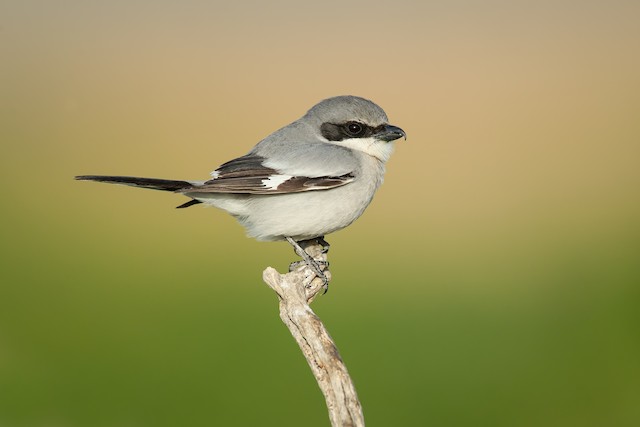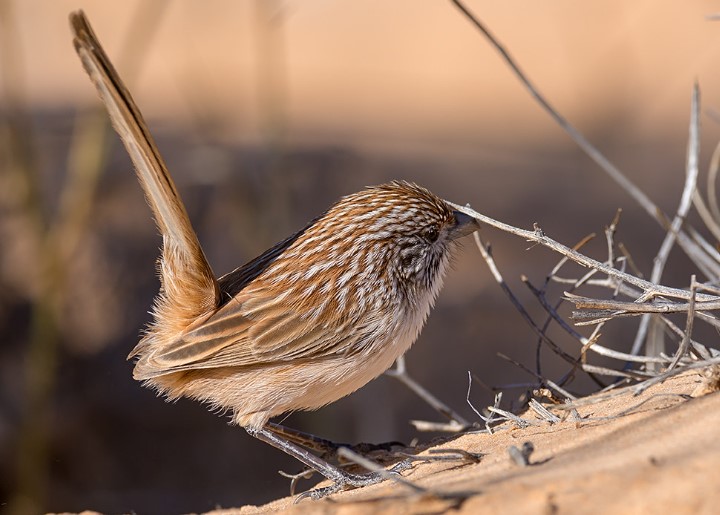Loggerhead Shrike Call
According to Wikipedia, the loggerhead Shrike song range is broad and varied and has been described as harsh and jarring. The bird notes include squeaky whistles, shrill trills, and guttural warbles. The trills sung by males during breeding season vary in rhythm and pitch.
Therefore, when feeling in danger and then alarmed, a shrike will produce a “schgra-a-a” shriek while spreading out its tail feathers. Nestlings will make “tcheeek” and “tsp” sounds shortly after hatching. During courtship feedings, females may ask for food with “mak” begging notes; conversely, male birds emit “wuuut” or “shack” sounds to offer food. The male bird emits a territorial, harsh shriek, while the female’s song is pitched lower and softer than the male’s. Usually, the male is far more vocal than the female.
The Loggerhead Shrike is a passerine bird species in the family Laniidae. It is found in North America and is known for its distinctive hunting behavior, in which it impales its prey on thorns or barbed wire fences. Loggerhead Shrikes are medium-sized birds with a grey back, white underparts, and black masks and wings. They feed on insects, small mammals, and reptiles. Populations of Loggerhead Shrikes have declined in recent decades due to habitat loss and other factors, and they are considered a species of conservation concern in some areas.
Although Loggerhead Shrike is known to prey on small vertebrates, most authors consider birds to be a minor portion of their diet. The birds at no time comprise more than 15% of the food in his analysis of the predatory behavior of Loggerhead Shrikes (Lanius ludovicianus) in California, which does not record a single instance of shrikes preying on other passerines. Analysis of the stomach contents of Loggerhead Shrikes indicates that birds account for only 1-8% of their annual food intake.
Thus, in most situations, the incidence of avian prey in a shrike’s diet is relatively low. However, the impact of this limited predation on the avifauna of a particular area has not been assessed. This is a situation in which Loggerhead Shrikes reduced the density of other passerines nesting in a sagebrush environment and effectively eliminated the production of young by the three species commonly nesting in this habitat.

Information presented here was gathered in conjunction with an investigation of avian populations on the Idaho National Engineering Laboratory (INEL) Site, approximately 48 km west of Idaho Falls, Idaho. A 4-ha study grid was established in each of the two areas, dominated by big sagebrush (Artemisia tridentata), that was nearly 12 km apart.
During 1976 and 1977, the breeding activities of all birds nesting within the study areas were carefully monitored. Nests were located by flushing a bird from a nest or by observing nest building, courtship, or food-carrying behavior and then rigorously searching the area for the nest.
Nests were checked at 1-2-day intervals. Nesting success was calculated as the number of successful nests (those producing at least one fledged young) divided by the total number of nests in which eggs were laid. The Loggerhead Shrike is a conspicuous and fairly common nesting species in the sagebrush habitat of the Snake River Plain.

Shrikes did not nest in either study area in 1976, although they were occasionally (albeit rarely) observed hunting in the grid systems. In 1977, a pair of shrikes was nested in each of the study areas. This provided the opportunity to compare the nesting density and success rates of other species with and without the presence of shrikes.
The Chi-square test was used for statistical comparisons. There were no significant differences in nesting density or nesting success between the two study areas in 1976 or 1977. This permitted the data from both areas to be pooled for a comparison between the 2 yr. In 1976, 22 of 29 (76%) passerine nests within the grids were successful. In 1977, only 14 nests (excluding shrike nests) were in the study areas.
This was significantly fewer than the previous year. Additionally, only one nesting pair successfully fledged young. This success rate (7%) was significantly below that calculated for 1976. In 1977, one pair of shrikes fledged 7 young, while the other fledged 9.

Here you can listen to the loggerhead shrike call.
Read More – The Curlew Bird and Its Cousin
Product You May be Interested
- Feel Emotional Freedom! Release Stress, Heal Your Heart, Master Your Mind
- 28-Day Keto Challenge
- Get Your Customs Keto Diet Plan
- A fascinating approach to wipe out anxiety disorders and cure in just weeks, to become Anxiety free, relaxed, and happy.
- Flavor Pairing Ritual Supercharges Women’s Metabolisms
- The best Keto Diet Program
- Boost Your Energy, Immune System, Sexual Function, Strength & Athletic Performance
- Find Luxury & Designer Goods, Handbags & Clothes at or Below Wholesale
- Unlock your Hip Flexors, Gives you More Strength, Better Health, and All-Day Energy.
- Cat Spraying No More – How to Stop Your Cat from Peeing Outside the Litter Box – Permanently.
- Anti-aging nutritional unexplained weight gain, stubborn belly fat, and metabolic slowdown. Reach Your Desired Weight in a Week and Stay There.
- Get All Your Healthy Superfoods In One Drink






